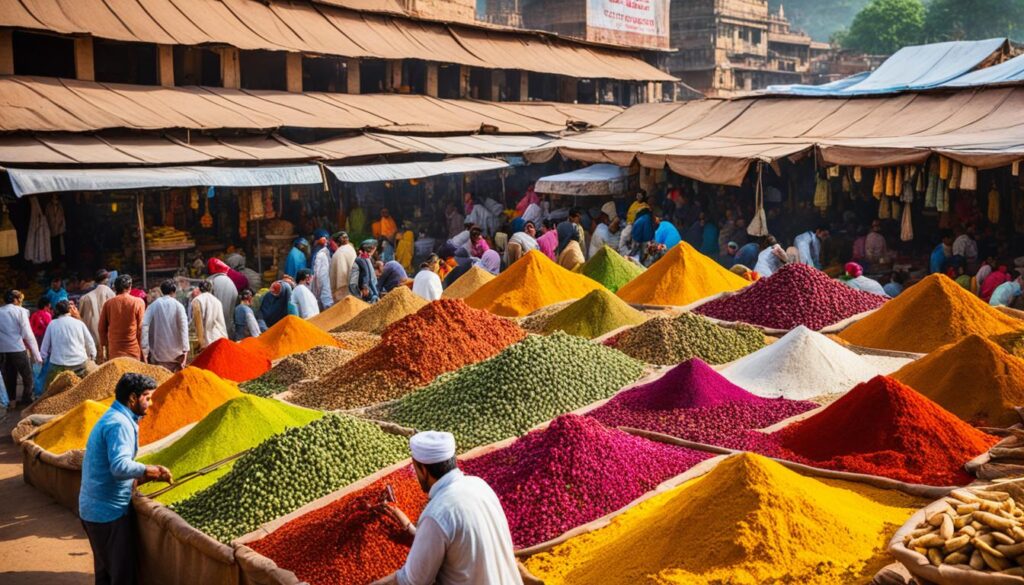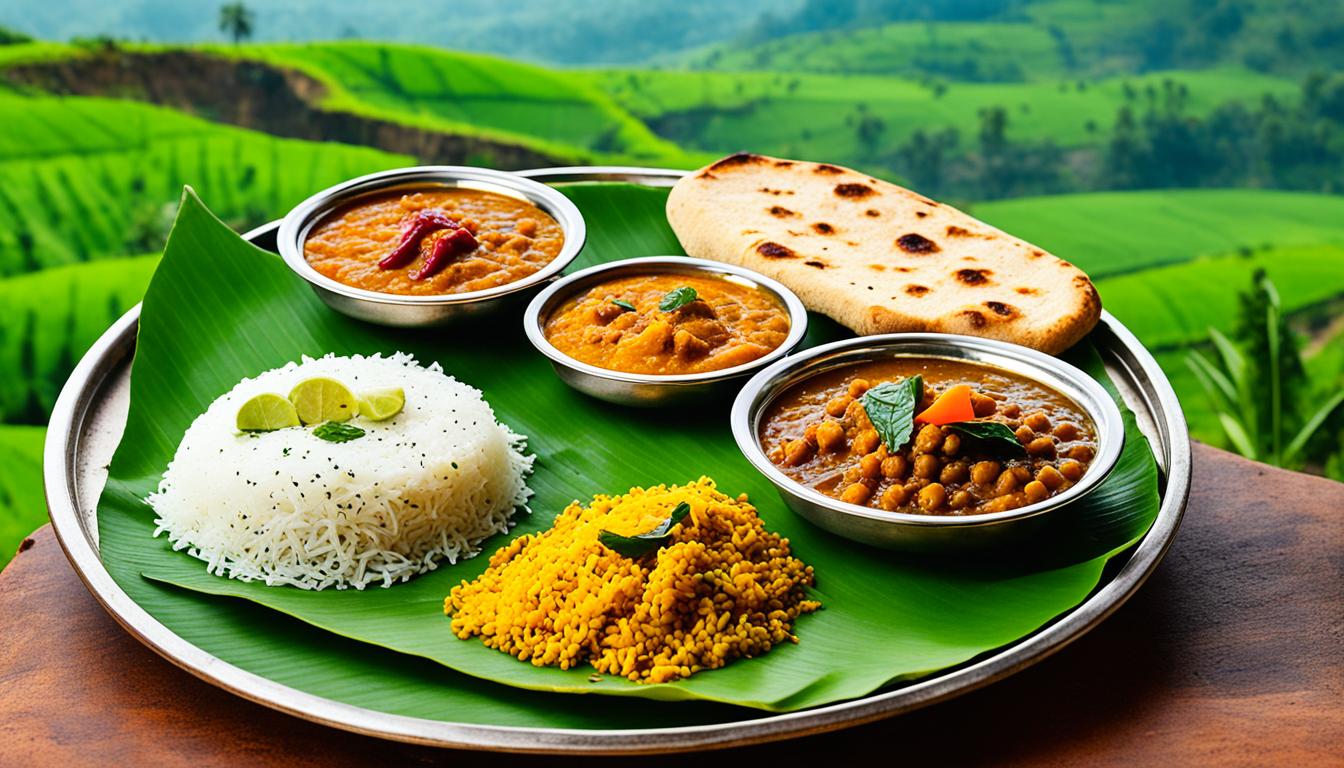When it comes to authentic Indian recipes, few can match the sheer simplicity and captivating flavors of Ajji & Deshastha Khandeshi Maharashtrian cuisines. But have you ever wondered what sets these regional Indian cooking styles apart? What makes them truly special and cherished by those who taste them?
Join us on a culinary journey as we unravel the secrets of Ajji’s kitchen and delve into the roots of Deshastha Khandeshi cuisine. Discover the rich cultural significance, the significance of dietary restrictions, and the everyday staples that come together to create a truly indulgent Maharashtrian dining experience. From traditional recipes passed down through generations to fascinating tales of Ajji’s childhood, this article will leave you craving for more.
Key Takeaways:
- Explore the flavors of Ajji & Deshastha Khandeshi Maharashtrian cuisines
- Uncover the cultural significance and dietary restrictions behind these traditional recipes
- Discover the everyday staples that make Deshastha Khandeshi cuisine so unique
- Get a glimpse into Ajji’s childhood and her culinary journey
- Appreciate the savory and flavorful experience of Maharashtrian cuisine
Ajji’s Kitchen and Traditional Recipes.
In Ajji’s kitchen, the heart of our home, flavors came alive through the art of traditional cooking. The air was always filled with the tantalizing aroma of homemade Indian meals, created with love and passion. As Ajji tirelessly prepared dishes like two kinds of sabzi, dal, and rotis, the anticipation grew. The kitchen bustled with activity, with Ajji’s skilled hands gracefully maneuvering pots and pans with precision.
Ajji’s passion for cooking shone through in every dish she made. She took immense pride in her ability to feed her loved ones and ensured that no one left the table unsatisfied. With generous portions and a sprinkle of love, Ajji’s homemade meals were nothing short of delightful.
These traditional recipes were not written down; they were passed down through generations, allowing for flexibility and creativity in the kitchen. Instead of fixed recipes, Ajji relied on observation and practice to perfect her culinary skills. Each time she cooked, she effortlessly adjusted the seasoning, spices, and proportions based on her instinct and experience.
“Have more dal,” Ajji would insist, making sure there was enough to go around. Ghee was an essential accompaniment to every meal, and she would personally ensure that each plate had its fair share. These small touches and attention to detail made every meal feel like a celebration of flavors and love.”
Ajji’s traditional recipes captured the essence of Deshastha Khandeshi Maharashtrian Indian cuisines. Passed down from generations, these recipes reflected the rich culinary heritage of the region and its emphasis on homemade goodness. With each dish, Ajji brought to life the best Indian cuisine recipes, infusing them with her own signature touches and elevating them to new heights.
The Magic of Ajji’s Kitchen
In Ajji’s kitchen, the magic happened. It was a place of creativity and warmth, where the aroma of spices danced in the air. While she cooked, Ajji would share stories, anecdotes, and wisdom, making the kitchen a hub of love and laughter. The kitchen was more than just a place to prepare meals; it was the heart of our family. Every day, we eagerly gathered around Ajji, anticipating the culinary delights that awaited us.
Her kitchen was not only a space for cooking but also a space for learning and bonding. It was where Ajji taught us the art of Indian cooking, passing on her wisdom and techniques. From mastering the perfect roti to understanding the balance of flavors in a curry, Ajji’s kitchen taught us more than just recipes. It taught us the importance of tradition, family, and the joy of sharing a homemade meal.
Ajji’s kitchen was a treasure trove of unforgettable memories, where the taste of love and tradition blended seamlessly in each dish. It was a place where we felt nourished not only by the food but also by the love and care that went into its creation.
The Roots of Deshastha Khandeshi Cuisine.
Deshastha Khandeshi cuisine has deep roots in the Deshastha Brahmin community that settled in the Khandesh region. The cuisine developed as a result of the community’s reliance on grain-based dishes due to the scarcity of fresh produce. Despite the challenging climate, Deshastha Khandeshi cuisine is known for its inventive flavors and the use of spice.
The staple foods of the region reflect the Deshastha Brahmin community’s culinary preferences. Bhakri, a coarse flatbread made with millets, is commonly consumed. Thecha, a spicy chutney made with chili peppers, and varnacha gola, a thick dal dish, are also popular. These dishes showcase the love for spice that is characteristic of Deshastha Khandeshi cuisine.
Inspired by the availability of locally sourced ingredients, Deshastha Khandeshi cuisine focuses on creating simple variations that transform everyday meals into indulgent experiences. The cuisine’s inventive nature allows for a wide range of flavors and dishes, ensuring every meal is flavorful and satisfying.
Despiste the limitations imposed by the climate, Deshastha Khandeshi cuisine uses traditional cooking techniques and spices to infuse every dish with rich flavors. The cuisine’s ability to adapt to the scarcity of resources and create delicious meals showcases the ingenuity and creativity of the Deshastha Brahmin community in the Khandesh region.
Key Features of Deshastha Khandeshi Cuisine:
- Reliance on grain-based dishes
- Love for spice and the use of chili peppers
- Staple foods include bhakri, thecha, and varnacha gola
- Inventive variations that turn everyday meals into indulgent experiences
| Dishes | Description |
|---|---|
| Bhakri | A coarse flatbread made with millets |
| Thecha | A spicy chutney made with chili peppers |
| Varnacha Gola | A thick dal dish |
Cultural Significance and Dietary Restrictions.
The Deshastha Brahmin community strictly follows vegetarianism, which is deeply rooted in the caste system of India. Ajji’s family, being Brahmins, strictly adhered to a vegetarian diet and abstained from cooking or consuming meat. Dietary restrictions related to caste and social status were significant in the region, with the cuisine reflecting these traditions. The focus on vegetarianism and the use of locally available grains and pulses contributed to the flavorful and nutritious nature of Deshastha Khandeshi cuisine.
Traditional Vegetarianism
The Deshastha Brahmin community, to which Ajji belongs, upholds vegetarianism as a core cultural and religious practice. This dietary choice is rooted in spiritual beliefs and the principle of ahimsa (non-violence), emphasizing respect for all living beings. By abstaining from meat consumption, the community aims to lead a compassionate and non-harmful lifestyle.
“Our family has always strictly followed vegetarianism. It is not just about the food we eat but also about the values we uphold.”
Reflection of Caste and Social Status
In India, dietary choices have historically been influenced by the caste system, which divided society into hierarchical groups based on birth. Brahmins, considered the highest caste, were expected to refrain from consuming meat and alcohol. As a part of this community, Ajji’s family adhered to these dietary restrictions, demonstrating their social status and cultural identity.
Flavorful Vegetarian Delights
The focus on vegetarianism within Deshastha Khandeshi cuisine has led to the exploration of a diverse range of plant-based ingredients and cooking techniques. With an emphasis on utilizing locally available grains, pulses, vegetables, and spices, the cuisine has developed a reputation for its unique flavors and robust aromas.
“We have always found joy in transforming simple ingredients into flavorful vegetarian dishes. This is a part of our cultural heritage and an expression of our identity.”
Ajji’s kitchen mirrors the cultural and dietary customs of the Deshastha Brahmin community, demonstrating a deep-rooted respect for vegetarianism and the vibrant flavors it offers. Through Ajji’s culinary expertise, one can experience the rich heritage and traditional tastes of Deshastha Khandeshi Maharashtrian cuisine.
Everyday Staples and Indulgent Pleasures.
The Deshastha Khandeshi cuisine features a range of everyday staples that form the backbone of traditional meals. These staples primarily revolve around hardy millets like jowar and bajra, which are known for their nutritional value and ability to sustain energy levels. The cuisine also incorporates a love for spice, creating flavorful dishes that satisfy the taste buds.
One of the key aspects of Deshastha Khandeshi cuisine is the abundant use of buttermilk, which adds a refreshing tanginess to many dishes. This not only enhances the flavor but also helps balance the spiciness present in the cuisine.
Savory Indulgences
While the everyday staples provide nourishment and sustenance, Deshastha Khandeshi cuisine also offers a range of indulgent dishes that elevate meals into memorable experiences. These dishes feature simple variations that bring out the richness of flavors and make every bite a savory pleasure.
“The fusion of everyday staples and indulgent pleasures in Deshastha Khandeshi cuisine showcases the creativity and versatility of traditional Indian flavors.”
One such indulgent dish is varan phal, a flavorful combination of lentils and pasta. The lentils are cooked to perfection with aromatic spices, while the pasta provides a delightful texture. Another dish, vangyache bharit, is made with roasted eggplants mashed with a blend of spices and topped with a tadka (tempering) of mustard seeds and curry leaves. The resulting dish is a symphony of smoky flavors and velvety texture.
A Glimpse of Khandesh and Ajji’s Childhood.
In the arid region of Khandesh, Ajji’s childhood was shaped by the challenging circumstances and the loss of her mother. Growing up in a Deshastha Brahmin family, Ajji’s kitchen was a blend of Deshastha and Khandeshi influences. Despite the hardships, Ajji managed to find solace in lifelong friendships, vibrant festivals, and, of course, the mouthwatering traditional Maharashtrian food that filled her home.
The region of Khandesh is known for its extensive grain cultivation, and this agricultural abundance had a significant impact on Ajji’s culinary journey. With an emphasis on nutritious and affordable ingredients, Ajji’s family ingrained a love for spice in the dishes they prepared. The flavors of Khandeshi cuisine combined with the Deshastha Brahmin traditions resulted in a unique and enticing array of flavors that Ajji inherited.
“Even in the face of adversity, the rich cultural heritage of Khandesh and the flavors of our traditional Maharashtrian food brought joy and comfort to our lives,” says Ajji, reminiscing about her childhood.
Ajji’s childhood experiences and the influence of Khandeshi cuisine laid a strong foundation for her culinary expertise. The spices, techniques, and recipes passed down through generations shaped Ajji’s cooking style and helped her create authentic Maharashtrian dishes that continue to delight her family and friends.

| Khandeshi Cuisine Influences | Deshastha Brahmin Traditions |
|---|---|
|
|
Conclusion.
Ajji’s cooking and Deshastha Khandeshi cuisine offer a delightful exploration into the flavors of Maharashtra. This traditional Maharashtrian food combines simple everyday staples with indulgent pleasures, showcasing the creativity and rich heritage of the region’s culinary traditions.
From Ajji’s kitchen, where the aroma of homemade Indian meals filled the air, to the cultural significance and dietary restrictions of the Deshastha Brahmin community, each aspect plays a role in shaping the authentic and flavorful experience of Deshastha Khandeshi cuisine. The cuisine’s emphasis on vegetarianism, use of spice, and incorporation of locally available grains and pulses contribute to its unique and savory taste.
By delving into the authentic recipes and culinary insights passed down through generations, one can truly appreciate the vibrant and diverse array of flavors that Maharashtrian cuisine has to offer. Whether it’s the comforting varan phal, flavorful shev bhaji, or refreshing kakdichi koshimbir, Deshastha Khandeshi cuisine embodies the true essence of Indian culinary heritage.
